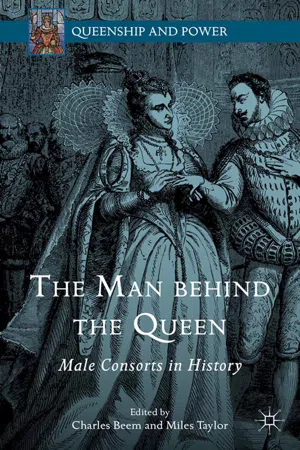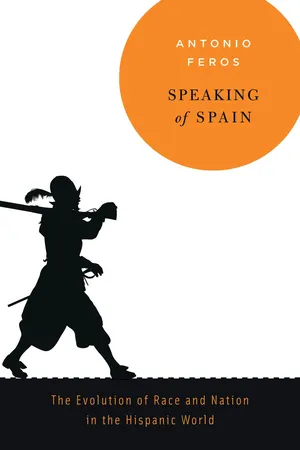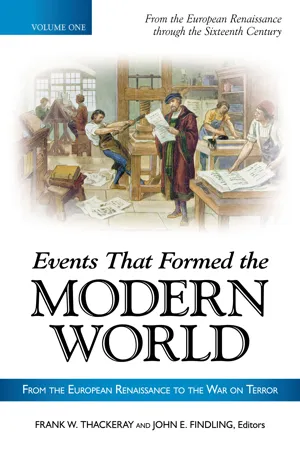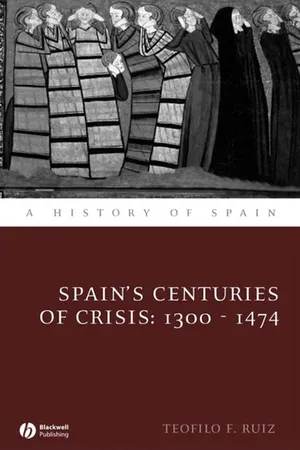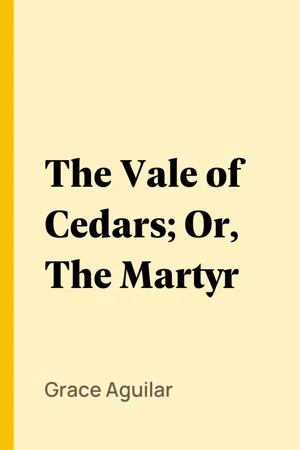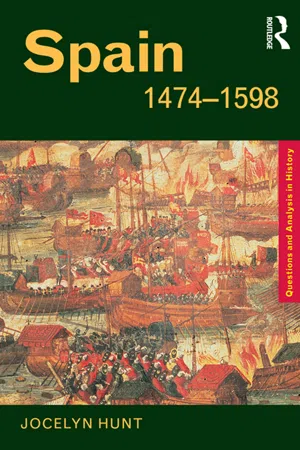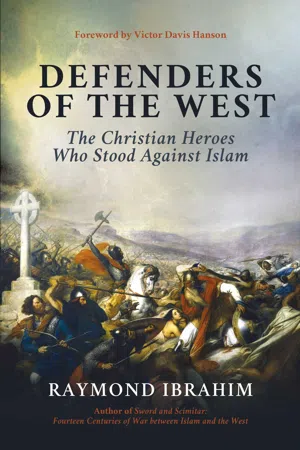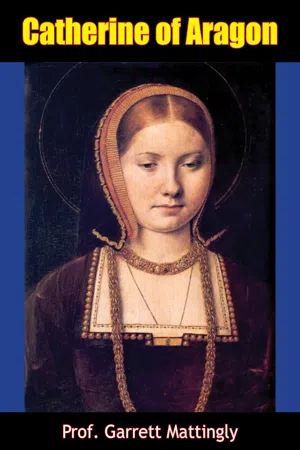History
Ferdinand and Isabella
Ferdinand and Isabella were the king and queen of Spain who ruled during the late 15th and early 16th centuries. They are best known for their role in the completion of the Reconquista, the establishment of the Spanish Inquisition, and for sponsoring the first voyage of Christopher Columbus, which led to the beginning of European exploration and colonization of the Americas.
Written by Perlego with AI-assistance
Related key terms
9 Key excerpts on "Ferdinand and Isabella"
- eBook - ePub
The Man behind the Queen
Male Consorts in History
- C. Beem, M. Taylor, C. Beem, M. Taylor(Authors)
- 2014(Publication Date)
- Palgrave Macmillan(Publisher)
HAPTER 2 Ferdinand the Catholic: King and Consort David AbulafiaThe subject of this essay is one that presents special methodological difficulties. To write about Ferdinand without Isabella until recently seemed unthinkable. The tendency to treat the two Reyes Católicos as a single unit is expressed not merely in the grant of that title by Pope Alexander VI in 1496, but also in the titles of two of the most recent books on their rule over Spain, Miguel Ángel Ladero Quesada’s La España de los Reyes Católicos , and John Edwards’ identically titled The Spain of the Catholic Monarchs .1 It is fair to state that these books are assessments of the state of the Spanish kingdoms rather than attempts to delineate the life of either ruler, and that they are firmly based in traditional interpretations of the two rulers; it is therefore only to be expected that they deal rather briefly with Ferdinand’s projects in Italy, the New World, and other lands beyond Iberia, even though these were developments with quite enormous consequences in the Mediterranean and in the wider world.In fact, the literature shows a heavy imbalance since most studies of the reign of Ferdinand have concentrated heavily on the period up to 1492. First he was occupied helping his wife to assert her authority in Castile, and then he was busily occupied with the conquest of Muslim Granada. Thus, José Angel Sesma Muñoz’ study of Fernando de Aragón, Hispaniarum Rex never in fact goes beyond 1492.2 The next 12 years of Ferdinand’s life have been passed over rather more rapidly, while the 12 years during which he outlived Isabella have been treated as no more than a codicil, as can be seen, for example, from the brief last chapter of John Edwards’ book, a mere eight pages summarily entitled “Crisis, Death and Legacy” in a work of 300 pages.3 This period might appear to be of minor interest at a colloquium on royal consorts, but it is important to take into account Ferdinand’s handling of Isabella’s legacy, and the changes of direction that were already apparent toward the end of her life, when he perhaps took advantage of her increasing ill-health. He in a sense resumed his role as royal consort not when he remarried—his second wife Germaine de Foix was not royal, though she brought him a firmer claim to the kingdom of Navarre—but as partner in government in Castile with his mentally unstable daughter Juana la Loca, who long outlived him, following the early death of her own Flemish consort Philip the Handsome.4 - eBook - ePub
- William Maltby(Author)
- 2008(Publication Date)
- Bloomsbury Academic(Publisher)
The marriage of Isabella of Castile and Ferdinand of Aragon on October 18, 1469, began the unification of the Spanish kingdoms and created the nucleus of a much larger empire. Both countries had by this time suffered from decades of intermittent civil war. Isabella, supported by most of the Castilian nobility, succeeded her half-brother Enrique IV in 1474. In an effort to prevent her accession, a faction associated with the late king allied themselves with Portugal, and launched a bloody but unsuccessful war that ended only in 1479. In that year the death of Ferdinand’s father made him King of Aragon. Aragon and Castile were now linked by marriage, but the union of the two crowns was—and would remain—personal. By the terms of their marriage agreement, Ferdinand ruled Aragon but had only limited rights in Castile; Isabella as ruler of Castile would have even fewer in Aragon and its dependencies. After each died, their common heir would become ruler of Spain, but he or she would inherit the two kingdoms separately (plus Sicily), and each kingdom would retain its own government, institutions, and privileges.The arrangement could have been a recipe for disaster. The young rulers differed in interests and personality, and their marriage, in private at least, was not entirely tranquil. Ferdinand, a model for Machiavelli’s Prince , was cynical and devious but a capable soldier and a master of diplomacy. The deeply religious Isabella was more interested in domestic policy and had the surer grasp of what would today be called public relations. Both, however, were pragmatists at heart. While Isabella lived, the royal couple pursued a common policy.By necessity, that policy was expansionist. Ferdinand and Isabella are correctly regarded as the founders of modern Spain, but they knew nothing of the modern concept of nationhood and did not consciously set out to create either a nation or an empire. Instead, like other rulers of the day, they based their policies on dynastic interest modified at times by religious considerations. Their first priority was to strengthen royal authority in Castile, now badly eroded by decades of strife and misrule. The situation in Aragon was equally bad, but Ferdinand believed that the kingdom’s long-established fueros precluded serious reform. Castilian institutions seemed more amenable to change. Even there, however, Isabella lacked the resources or the inclination to impose her authority by force. She needed the cooperation of nobles and town governments, and knew that this required incentives. At the Cortes of Toledo in 1480 Isabella confirmed the nobles in their possession of lands taken illegally before 1466 on condition that they return those taken thereafter. Throughout her reign, she granted mayorazgos that allowed them to entail portions of their estates, thereby avoiding the trap of partible inheritance which diluted the wealth of their families. Mayorazgos were an important favor, as were mercedes - eBook - ePub
- Antonio Feros(Author)
- 2017(Publication Date)
- Harvard University Press(Publisher)
1Spains
IN OCTOBER 1469, two young princelings—Isabel, eighteen, and her cousin Ferdinand, seventeen—married in a small Castilian town in virtual secrecy. As members of the same Trastámara dynasty, their marriage was an attempt to establish order and stability in the peninsula following decades of conflict, regicides, rebellions, and civil wars.Isabel became queen of the crown of Castile in 1474 when she succeeded her brother Enrique IV. Five years later, in 1479, Ferdinand became king of the crown of Aragon. This was strictly a union of heads, not bodies: the marriage accords did not call for, or envisage, a true political and juridical union of the two crowns and their kingdoms. Nevertheless, the practical result of the marriage was that for the first time in centuries, the two most powerful states in the Iberian Peninsula were dynastically amalgamated.Many nineteenth- and twentieth-century historians claimed that this fateful union of the crowns of Aragon and Castile stitched together a territorial unit rent asunder by the eighth-century Arab invasion of the peninsula and also unquestionably marked the birth of Spain as a nation and state. In the past few decades, however—at least since the establishment of democracy in Spain in the 1970s—historians have challenged this interpretation. In their view, the marriage of Ferdinand and Isabel did not forge a nation, and the old kingdoms survived as autonomous entities with deeply entrenched “national” identities that have endured until the present day. Alternatively, a growing number of early modern historians have observed that one of the key if unintended consequences of the marriage between Isabel and Ferdinand was not the creation of a nation-state so much as the emergence of a well-defined Spanish national identity. They find evidence of this process in cultural and juridical concepts and practices that reveal an increasingly widespread sense among early modern Spaniards of belonging to a “Spanish” nation and in a growing popular tendency to self-identify unambiguously as “Spaniards.”1 - eBook - ePub
Events That Formed the Modern World
From the European Renaissance through the War on Terror [5 volumes]
- Frank W. Thackeray, John E. Findling, Frank W. Thackeray, John E. Findling, Frank W. Thackeray, John E. Findling(Authors)
- 2012(Publication Date)
- ABC-CLIO(Publisher)
When Isabella’s brother, Henry IV, died in 1474, Ferdinand and Isabella became joint monarchs of Castile. Then in 1479, Ferdinand’s father, John II of Aragon, died, and Ferdinand also ruled that kingdom. Although Ferdinand held important titles, he did not have absolute power in either Aragon or Castile, and the two rulers and their kingdoms had many differences. Linguistically, the people in those areas spoke different Spanish dialects. Strategically, Aragon had long been focused on the Mediterranean and Castile on the Atlantic. Furthermore, Ferdinand differed from Isabella in his skepticism toward religion and his tendency toward tolerance in that area. Those differences were underscored when Ferdinand agreed to make no wars or alliances unless Isabella approved of them and to appoint only Castilians to high office in Castile. The arrangement signified that Castile had the greatest wealth and the most prominent position in the political linkage.Ferdinand had great abilities as a statesman and applied his penchants for deceit, crassness, and opportunism. He and Isabella realized that to strengthen the Crown, they needed new sources of revenue. They turned to the Catholic Church, and in 1486, the pope granted them patronage rights over bishoprics to be established in the areas from which the Moors, or Muslims, had been driven. The pope also issued bulls, or decrees, in 1493, 1501, and 1508 granting them control over ecclesiastical appointments and revenues in the Americas. The New World would prove to be a lucrative source for the Crown. The Church thus became an important tool in developing royal absolutism. In return, Ferdinand and Isabella strongly supported the pope’s prerogative in spiritual matters, a loyalty that earned them the title “the Catholic Sovereigns,” granted by Pope Alexander VI.Ferdinand V ruled jointly with his wife Isabella. This famous couple was responsible for sending Christopher Columbus on his way across the Atlantic and unifying Spain. Devoutly Catholic, they also forced their non-Christian subjects to either convert or emigrate. (Library of Congress) - eBook - ePub
Spain's Centuries of Crisis
1300 - 1474
- Teofilo F. Ruiz(Author)
- 2011(Publication Date)
- Wiley-Blackwell(Publisher)
12 As we come to the end of this political narrative for Castile, one must acknowledge that while the marriage of Ferdinand and Isabella is rightly considered a watershed in the political history of the peninsula, for contemporaries the union in 1469 represented yet another chapter, and not a promising one, of Spain’s troubled late medieval history. It would take another decade to restore some semblance of order in Castile, and this could not have been possible without Ferdinand’s cunning political skills and Aragonese contributions. The son of one of the most notorious troublemakers helped lay the foundations of an ordered and well-policed society as Spain, and above all Castile, was propelled into the modern world.The Trastámaras in Aragon, 1412–1479The history of the Crown of Aragon in this period was a very different one from that of Castile. Ferdinand of Antequera’s ascent to the thrones of the diverse realms of the Crown of Aragon in 1412 was never an easy process. His capture of Antequera in 1410, a signal victory in the long history of peninsular Reconquest, and his steady hand as co-regent for his young nephew John II had propelled him to a prominent place in Iberian affairs. When Martin the Humane died without heirs in May 1410, Ferdinand became one of several candidates to the throne of the Realms of Aragon. The closest familial claim was that of Frederick (Federico), the bastard son of Martin the Younger, that is, the grandson of Martin the Humane, but Federico’s illegitimacy, long connection to Sicily, and general lack of support in the peninsula made him an untenable candidate. Other main contenders emerged along with a bevy of foreign and local pretenders to the Crown. The first of the two main candidates was Jaume d’Urgell, a descendant of Alfonso IV. The second, and successful, candidate was Ferdinand of Antequera, who also had strong family connections to the last Aragonese king. Ferdinand’s mother, Eleanor, was Martin the Humane’s sister. - eBook - ePub
- Grace Aguilar(Author)
- 2004(Publication Date)
- Perlego(Publisher)
The moment Henry became aware of this marriage, the civil struggle recommenced. In vain the firm, yet pacific Archbishop of Toledo recalled the consent he had given, and proved that the union not only secured the after-glory of Spain, but Henry's present undisturbed possession of his throne. Urged on by his wife, and his intriguing favorite, the Marquis of Villena, who was for ever changing sides, he published a manifesto, in which he declared on oath that he believed Joanna to be his daughter, and proclaimed her heiress of Castile. Ferdinand and Isabella instantly raised an array, regardless of the forces of Portugal (to whose monarch Joanna had been betrothed), who were rapidly advancing to the assistance of Henry. Ere, however, war had regularly commenced, a brief respite was obtained by the death of Henry, and instantly and unanimously Isabella was proclaimed Queen of Leon and Castile. Peace, however, was not instantly regained; the King of Portugal married Joanna, and resolved on defending her rights. Some skirmishing took place, and at length a long-sustained conflict near Fero decided the point—Ferdinand and the Castilians were victorious; the King of Portugal made an honorable retreat to his own frontiers, and the Marquis of Villena, the head of the malcontents, and by many supposed to be the real father of Joanna, submitted to Isabella. Peace thus dawned for Castile; but it was not till three years afterwards, when Ferdinand had triumphed over the enemies of Arragon, and succeeded his father as Sovereign of that kingdom, that any vigorous measures could be taken for the restoration of internal order.The petty Sovereignties of the Peninsular, with the sole exception of the mountainous district of Navarre, and the Moorish territories in the south, were now all united; and it was the sagacious ambition of Ferdinand and Isabella to render Spain as important in the scale of kingdoms as any other European territory; and to do this, they knew, demanded as firm a control over their own subjects, as the subjection of still harassing foes.Above a century had elapsed since Spain had been exposed to the sway of weak or evil kings, and all the consequent miseries of misrule and war. Rapine, outrage, and murder had become so frequent and unchecked, as frequently to interrupt commerce, by preventing all communication between one place and another. The people acknowledged no law but their own passions. The nobles were so engrossed with hatred of each other, and universal contempt of their late sovereign, with personal ambition and general discontent, that they had little time or leisure to attend to any but their own interest. But a very brief interval convinced both nobles and people that a new era was dawning for them. In the short period of eighteen months, the wise administration of Isabella and Ferdinand, had effected a sufficient change to startle all ranks into the conviction that their best interests lay in prompt obedience, and in exerting themselves in their several spheres, to second the sovereign's will. The chivalric qualities of Ferdinand, his undoubted wisdom and unwavering firmness, excited both love and fear; while devotion itself is not too strong a term to express the national feeling entertained toward Isabella. Her sweet, womanly gentleness, blended as it was with the dignity of the sovereign; her ready sympathy in all that concerned her people—for the lowest of her subjects; doing justice, even if it were the proud noble who injured, and the serf that suffered—all was so strange, yet fraught with such national repose, that her influence every year increased; while every emotion of chivalry found exercise, and yet rest in the heart of the aristocracy for their Queen; her simple word would be obeyed, on the instant, by men who would have paused, and weighed, and reasoned, if any other—even Ferdinand himself—had spoken. Isabella knew her power; and if ever sovereign used it for the good, the happiness of her people, that proud glory was her own. - eBook - ePub
- Jocelyn Hunt(Author)
- 2015(Publication Date)
- Routledge(Publisher)
3 and although there was no campaign in the Holy Land, the campaign in North Africa preoccupied Ferdinand for much of his reign. Moorish pirates threatened the sea links to the Balearic Islands, as well as to Naples and, from the 1480s on, they were joined by the Ottoman Turks whose navies attacked Rhodes, Malta and even Sicily. Any land gained in North Africa would also have the effect of reducing Portuguese trading influence, and there was a possibility that colonisation might ease the problem of land shortage in Castile, where huge areas, for example the province of Estremadura, were, as the name implies, of limited fertility. In the event, however, Ferdinand established no more than coastal garrisons, for example at Mers el Kebir (1505), Oran (1509), Tripoli and Algiers (1510). These outposts were vulnerable to attack from corsairs, and were to be a source of anxiety to Charles during his reign.If interest in North Africa was one immediate consequence of the capture of Granada which could have been predicted, the sponsorship of Columbus to discover a short route to Asia was unexpected. In her gratitude to God, Isabella was more prepared to listen to Columbus than she had been in 1486. In the event, Columbus’ four exploring journeys reached only the West Indies and the mainland of Central America. By the time of Isabella’s death, concerns about the treatment of the native peoples were beginning to be expressed, and in 1512 the first attempts at government regulation, the Laws of Burgos, were promulgated. As was the case with so much of Ferdinand’s foreign policy, his successor, Charles was to find this a growing and intractable problem throughout his reign.Matters closer to home engaged the attention of the Catholic monarchs even before Columbus’ first departure. The provinces of Rosellon and Cerdena, in the Pyrenees between France and Aragon, had been occupied by France since 1462. Ferdinand, as ruler of Catalonia to whom they had previously belonged, was determined to repossess them. He was able to make an alliance with Henry VII of England in 1489 (at Medina del Campo). Henry’s accession to the throne of England had been materially assisted by the Duke of Brittany, and so Henry was angered by a French attack on his childhood protector. Although the treaty with Spain supposedly concerned Brittany, Ferdinand attacked the Pyrenean provinces and was recognised as their ruler by the Treaty of Barcelona (1493). Ferdinand’s other claim in the Pyrenees concerned Navarre. During the unrest in Aragon which preceded Ferdinand’s accession, Navarre had declared its independence, but there was a dispute between the families of de Foix and d’Albret over which should rule. In 1506, Ferdinand married Germaine de Foix, to enhance his claim, and to prevent the King of France gaining control of her; but he did not take action until 1512, when he was again at war against France. He demanded the right to use Navarre as a springboard for his attack into France, and d’Albret’s refusal provided him with the excuse he needed to annex Navarre, which remains Spanish to this day. - eBook - ePub
Defenders of the West
The Christian Heroes Who Stood Against Islam
- Raymond Ibrahim(Author)
- 2022(Publication Date)
- Bombardier Books(Publisher)
Naturally, Christians did not see it this way. They had merely liberated and restored what was Christian land centuries before Muslims had invaded and forcibly Islamized it.On December 22, 1248, Ferdinand—“the tyrant, the accursed one,” as Muslims were wont to describe their conqueror—made his procession into Seville, and worshipped in that city’s principle mosque, now a cathedral. Such a splendid prize, he established his seat in and spent his energy on repopulating Seville, even as roaming bands of “moors were [forever] awaiting any opportunity to kill him.”125FinaleNow that virtually the whole of Spain was under Christian authority, the indefatigable Ferdinand began “making preparations to pass over to Africa, there to crush the Mahometan empire,” in the context of joining the Crusade of his younger cousin, the king of France.126 But by now, his already ailing body, ravaged by more than twenty years of privations, austerities, and warfare, would not allow for such a venture.Right before commencing his African adventure, his old sickness struck him with extreme ferocity, and, on May 30, 1252, King Ferdinand III of Castile-León died, aged fifty-two. He was about four years younger than his ancestor, the Cid, who had also died from the ravages of a lifetime of nonstop warfare.Although Ferdinand’s career was not overly long—his Aragonese counterpart, James I, reigned for sixty-three years—much was accomplished in it. In the twenty years between 1228 and 1248 he spearheaded the Reconquista into central al-Andalus and ended up as undisputed lord and king of not only the northern Christian kingdoms of Castile, Toledo, León, and Galicia, but the great and southern Moorish kingdoms of Murica, Córdoba, Jaen, and Seville. The kingdom he bequeathed to his son, Alfonso X, was significantly larger than the one he inherited—due to the addition of Andalusian cities. As Ferdinand had from his deathbed explained to his successor: - eBook - ePub
- Prof. Garrett Mattingly(Author)
- 2017(Publication Date)
- Papamoa Press(Publisher)
The family into which Catherine was born seemed certain to have as large a voice in the fate of Europe as any. Both her parents were kings in their own right, and their marriage, uniting their crowns, made the beginning of a new national state which grew by war and policy and accident throughout Catherine’s girlhood to a great dynastic power, enriched by fabulous new-found lands, and struggling for first place in Europe. Her father, Ferdinand, inherited the half-dozen crowns of Aragon, Mediterranean lands mostly, looking towards Italy, tugged at by eddies of Italian rivalries, and being sucked by them into the current of the new times. Into that current Ferdinand steered boldly. Ferdinand, himself, had little Italian culture; his earliest schools had been war and intrigue, and his usual seat from youth the saddle. In his passion for hunting and hawking and fighting, his quasi-illiteracy and conventional piety, he resembled any other feudal nobleman. But no Italian tyrant ever had a more unwavering, single-minded devotion to the realities of power. There was no remnant of medieval idealism about Ferdinand’s politics. He did the work of the new times, the consolidation of royal power, with instinctive, tropistic efficiency. Like his Mediterranean kingdoms, Catherine’s father belonged to the Renaissance.What counted most in Spain, however, was Castile; what counted most in the team of the Catholic Kings was the Queen of Castile; what counted most with Catherine was her mother. Castile was not modern; neither was Isabella, though both were willing to take something from the new to reinforce the old. The great central plateau of Spain preserved the psychology of the Middle Ages. Nowhere were the feudal lords prouder and more powerful, nowhere in western Europe were the towns weaker and fewer, nowhere was the Church more firmly lord of the hearts and minds of peasant and hidalgo. And Isabella, though she did the work of the future, belonged, like Castile, to the past. She was more curious than Ferdinand about the new learning, but she sought it not to surrender to its magic but to use it in the work she had to do. Like Ferdinand, and even more than Ferdinand, she had struggled to power, and she had been no more scrupulous than he about the means: fighting, lying, scheming ever since girlhood, leading armies and squirming through conferences, wheedling, meek, fiery, as it served her purpose, but always implacable until she had driven her niece, the rightful heir to the throne, into exile, tamed the grandees, and hammered Castile into one strong kingdom. But unlike Ferdinand, she was restless, not out of simple itch for power, but because God’s work is never done and it is laid upon the king to do God’s work. Castile was not a prize but a sword.As soon as she held it firmly, she turned it to the great medieval use of God’s sword, the Crusade. Even in Spain the memory of the Crusade was growing faint, and the rest of Europe had almost forgotten it. For two centuries the Moslems held the Holy Land undisturbed. Though the crescent moved westward and Constantinople fell, though the Turk threatened Hungary and raided the Italian coast, no Christian banner stirred. Defense against the Turk had become a phrase in European chanceries, good to embellish a treaty or a declaration of war against one’s neighbor. But to Isabella the Crusade was as real as it had been to Saint Bernard; that the conquest of Granada, the last Moslem kingdom in Spain, meant booty and the rounding-out of boundaries, was to her a secondary consideration. Ferdinand might seek power; she sought the glory of God. From different motives husband and wife joined forces, but the main burden lay on Castile, and the driving impulse came from Isabella. Her personal standard was familiar to the Moorish outposts. She rode in armor with her knights along the tracks of the snowy Sierras. She whipped up in her troops something of her own fanatical devotion to the cross. One by one the Moorish fortresses crumbled under the pounding of her modern guns; slowly the Moors gave way before her medieval passion.
Index pages curate the most relevant extracts from our library of academic textbooks. They’ve been created using an in-house natural language model (NLM), each adding context and meaning to key research topics.
